Business Ethics Report: Managerial Behavior and Ethical Approaches
VerifiedAdded on 2023/04/23
|8
|2541
|484
Report
AI Summary
This report delves into the multifaceted realm of business ethics, dissecting managerial behavior through the lenses of five key ethical approaches: fairness and justice, utilitarianism, virtue, rights, and the common good. It meticulously compares these approaches, highlighting their contributions to overall organizational benefits. Furthermore, the report investigates the ethical considerations surrounding the NHS approval of new drugs, specifically in the context of multiple sclerosis treatment, analyzing the application of consequentialism and the impact of cost-effectiveness. The analysis extends to the ethical implications of the NHS's decision-making process. Finally, the report examines a hypothetical scenario involving the BDL organization's recruitment strategy, critically evaluating the potential for discrimination when prioritizing young employees over those aged 50 and above, considering both the advantages and disadvantages of such practices. The report concludes by summarizing the key findings and their practical implications.

Running Head: Ethics 0
Business ethics
1/24/2019
Business ethics
1/24/2019
Paraphrase This Document
Need a fresh take? Get an instant paraphrase of this document with our AI Paraphraser
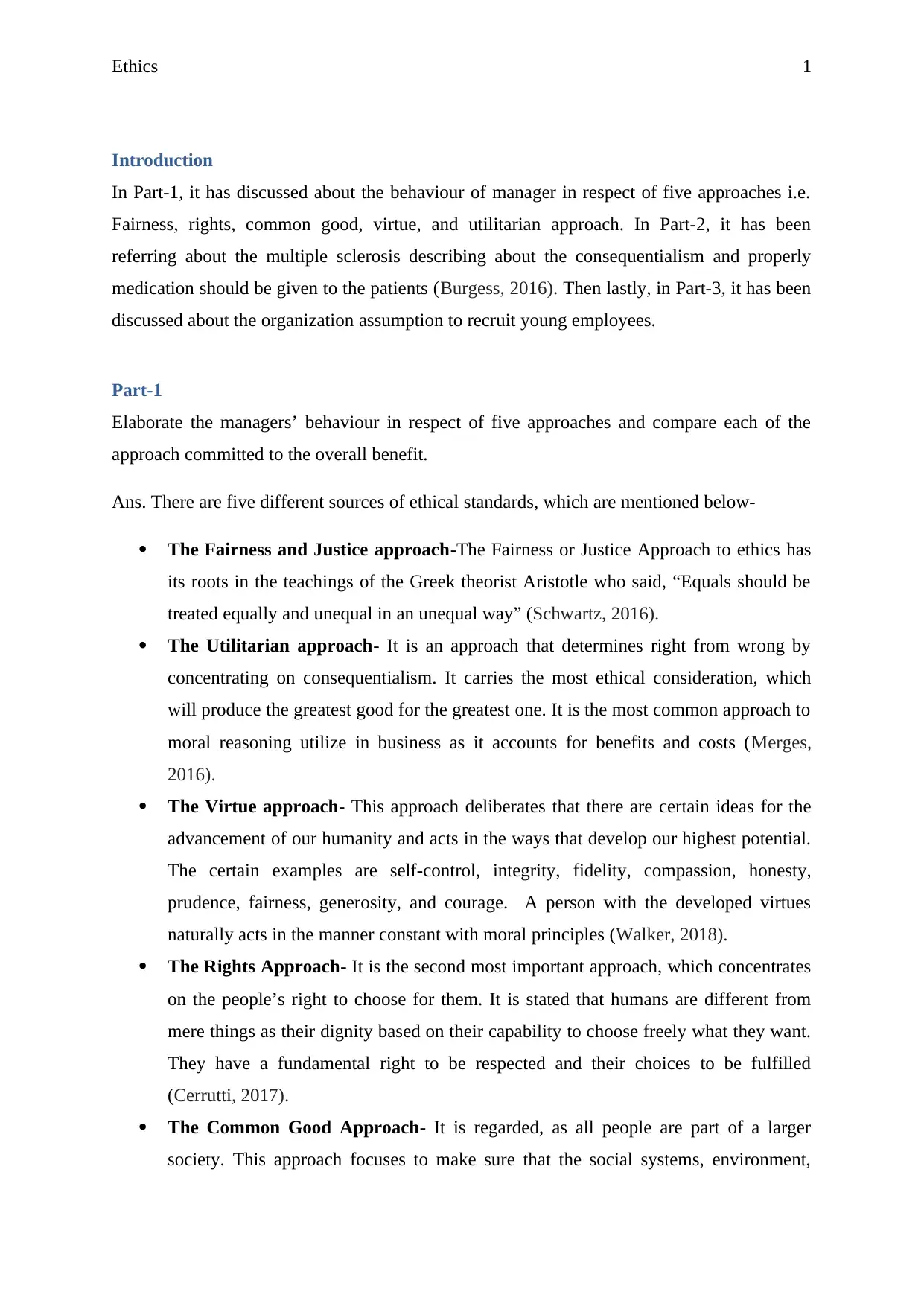
Ethics 1
Introduction
In Part-1, it has discussed about the behaviour of manager in respect of five approaches i.e.
Fairness, rights, common good, virtue, and utilitarian approach. In Part-2, it has been
referring about the multiple sclerosis describing about the consequentialism and properly
medication should be given to the patients (Burgess, 2016). Then lastly, in Part-3, it has been
discussed about the organization assumption to recruit young employees.
Part-1
Elaborate the managers’ behaviour in respect of five approaches and compare each of the
approach committed to the overall benefit.
Ans. There are five different sources of ethical standards, which are mentioned below-
The Fairness and Justice approach-The Fairness or Justice Approach to ethics has
its roots in the teachings of the Greek theorist Aristotle who said, “Equals should be
treated equally and unequal in an unequal way” (Schwartz, 2016).
The Utilitarian approach- It is an approach that determines right from wrong by
concentrating on consequentialism. It carries the most ethical consideration, which
will produce the greatest good for the greatest one. It is the most common approach to
moral reasoning utilize in business as it accounts for benefits and costs (Merges,
2016).
The Virtue approach- This approach deliberates that there are certain ideas for the
advancement of our humanity and acts in the ways that develop our highest potential.
The certain examples are self-control, integrity, fidelity, compassion, honesty,
prudence, fairness, generosity, and courage. A person with the developed virtues
naturally acts in the manner constant with moral principles (Walker, 2018).
The Rights Approach- It is the second most important approach, which concentrates
on the people’s right to choose for them. It is stated that humans are different from
mere things as their dignity based on their capability to choose freely what they want.
They have a fundamental right to be respected and their choices to be fulfilled
(Cerrutti, 2017).
The Common Good Approach- It is regarded, as all people are part of a larger
society. This approach focuses to make sure that the social systems, environment,
Introduction
In Part-1, it has discussed about the behaviour of manager in respect of five approaches i.e.
Fairness, rights, common good, virtue, and utilitarian approach. In Part-2, it has been
referring about the multiple sclerosis describing about the consequentialism and properly
medication should be given to the patients (Burgess, 2016). Then lastly, in Part-3, it has been
discussed about the organization assumption to recruit young employees.
Part-1
Elaborate the managers’ behaviour in respect of five approaches and compare each of the
approach committed to the overall benefit.
Ans. There are five different sources of ethical standards, which are mentioned below-
The Fairness and Justice approach-The Fairness or Justice Approach to ethics has
its roots in the teachings of the Greek theorist Aristotle who said, “Equals should be
treated equally and unequal in an unequal way” (Schwartz, 2016).
The Utilitarian approach- It is an approach that determines right from wrong by
concentrating on consequentialism. It carries the most ethical consideration, which
will produce the greatest good for the greatest one. It is the most common approach to
moral reasoning utilize in business as it accounts for benefits and costs (Merges,
2016).
The Virtue approach- This approach deliberates that there are certain ideas for the
advancement of our humanity and acts in the ways that develop our highest potential.
The certain examples are self-control, integrity, fidelity, compassion, honesty,
prudence, fairness, generosity, and courage. A person with the developed virtues
naturally acts in the manner constant with moral principles (Walker, 2018).
The Rights Approach- It is the second most important approach, which concentrates
on the people’s right to choose for them. It is stated that humans are different from
mere things as their dignity based on their capability to choose freely what they want.
They have a fundamental right to be respected and their choices to be fulfilled
(Cerrutti, 2017).
The Common Good Approach- It is regarded, as all people are part of a larger
society. This approach focuses to make sure that the social systems, environment,
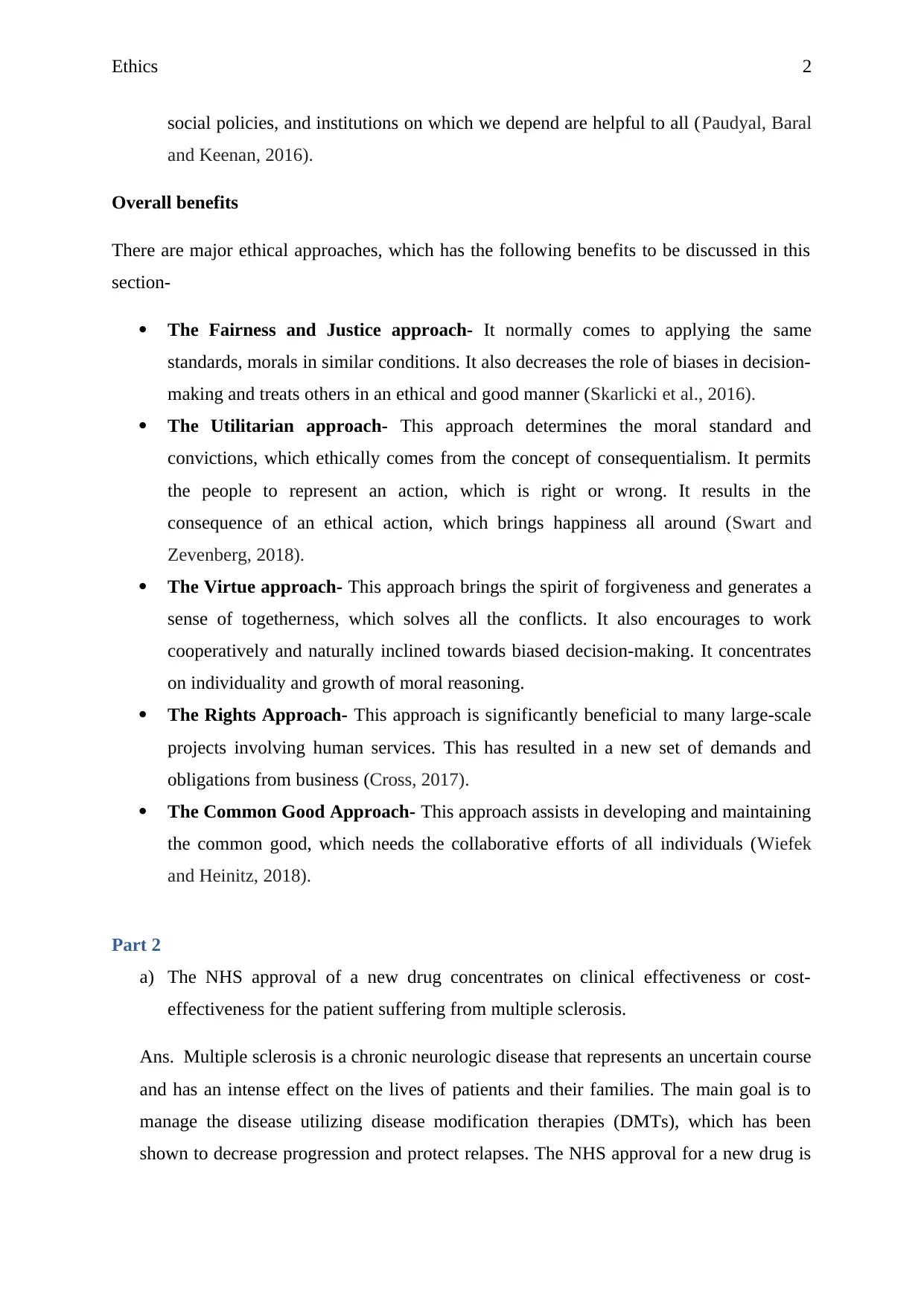
Ethics 2
social policies, and institutions on which we depend are helpful to all (Paudyal, Baral
and Keenan, 2016).
Overall benefits
There are major ethical approaches, which has the following benefits to be discussed in this
section-
The Fairness and Justice approach- It normally comes to applying the same
standards, morals in similar conditions. It also decreases the role of biases in decision-
making and treats others in an ethical and good manner (Skarlicki et al., 2016).
The Utilitarian approach- This approach determines the moral standard and
convictions, which ethically comes from the concept of consequentialism. It permits
the people to represent an action, which is right or wrong. It results in the
consequence of an ethical action, which brings happiness all around (Swart and
Zevenberg, 2018).
The Virtue approach- This approach brings the spirit of forgiveness and generates a
sense of togetherness, which solves all the conflicts. It also encourages to work
cooperatively and naturally inclined towards biased decision-making. It concentrates
on individuality and growth of moral reasoning.
The Rights Approach- This approach is significantly beneficial to many large-scale
projects involving human services. This has resulted in a new set of demands and
obligations from business (Cross, 2017).
The Common Good Approach- This approach assists in developing and maintaining
the common good, which needs the collaborative efforts of all individuals (Wiefek
and Heinitz, 2018).
Part 2
a) The NHS approval of a new drug concentrates on clinical effectiveness or cost-
effectiveness for the patient suffering from multiple sclerosis.
Ans. Multiple sclerosis is a chronic neurologic disease that represents an uncertain course
and has an intense effect on the lives of patients and their families. The main goal is to
manage the disease utilizing disease modification therapies (DMTs), which has been
shown to decrease progression and protect relapses. The NHS approval for a new drug is
social policies, and institutions on which we depend are helpful to all (Paudyal, Baral
and Keenan, 2016).
Overall benefits
There are major ethical approaches, which has the following benefits to be discussed in this
section-
The Fairness and Justice approach- It normally comes to applying the same
standards, morals in similar conditions. It also decreases the role of biases in decision-
making and treats others in an ethical and good manner (Skarlicki et al., 2016).
The Utilitarian approach- This approach determines the moral standard and
convictions, which ethically comes from the concept of consequentialism. It permits
the people to represent an action, which is right or wrong. It results in the
consequence of an ethical action, which brings happiness all around (Swart and
Zevenberg, 2018).
The Virtue approach- This approach brings the spirit of forgiveness and generates a
sense of togetherness, which solves all the conflicts. It also encourages to work
cooperatively and naturally inclined towards biased decision-making. It concentrates
on individuality and growth of moral reasoning.
The Rights Approach- This approach is significantly beneficial to many large-scale
projects involving human services. This has resulted in a new set of demands and
obligations from business (Cross, 2017).
The Common Good Approach- This approach assists in developing and maintaining
the common good, which needs the collaborative efforts of all individuals (Wiefek
and Heinitz, 2018).
Part 2
a) The NHS approval of a new drug concentrates on clinical effectiveness or cost-
effectiveness for the patient suffering from multiple sclerosis.
Ans. Multiple sclerosis is a chronic neurologic disease that represents an uncertain course
and has an intense effect on the lives of patients and their families. The main goal is to
manage the disease utilizing disease modification therapies (DMTs), which has been
shown to decrease progression and protect relapses. The NHS approval for a new drug is
⊘ This is a preview!⊘
Do you want full access?
Subscribe today to unlock all pages.

Trusted by 1+ million students worldwide
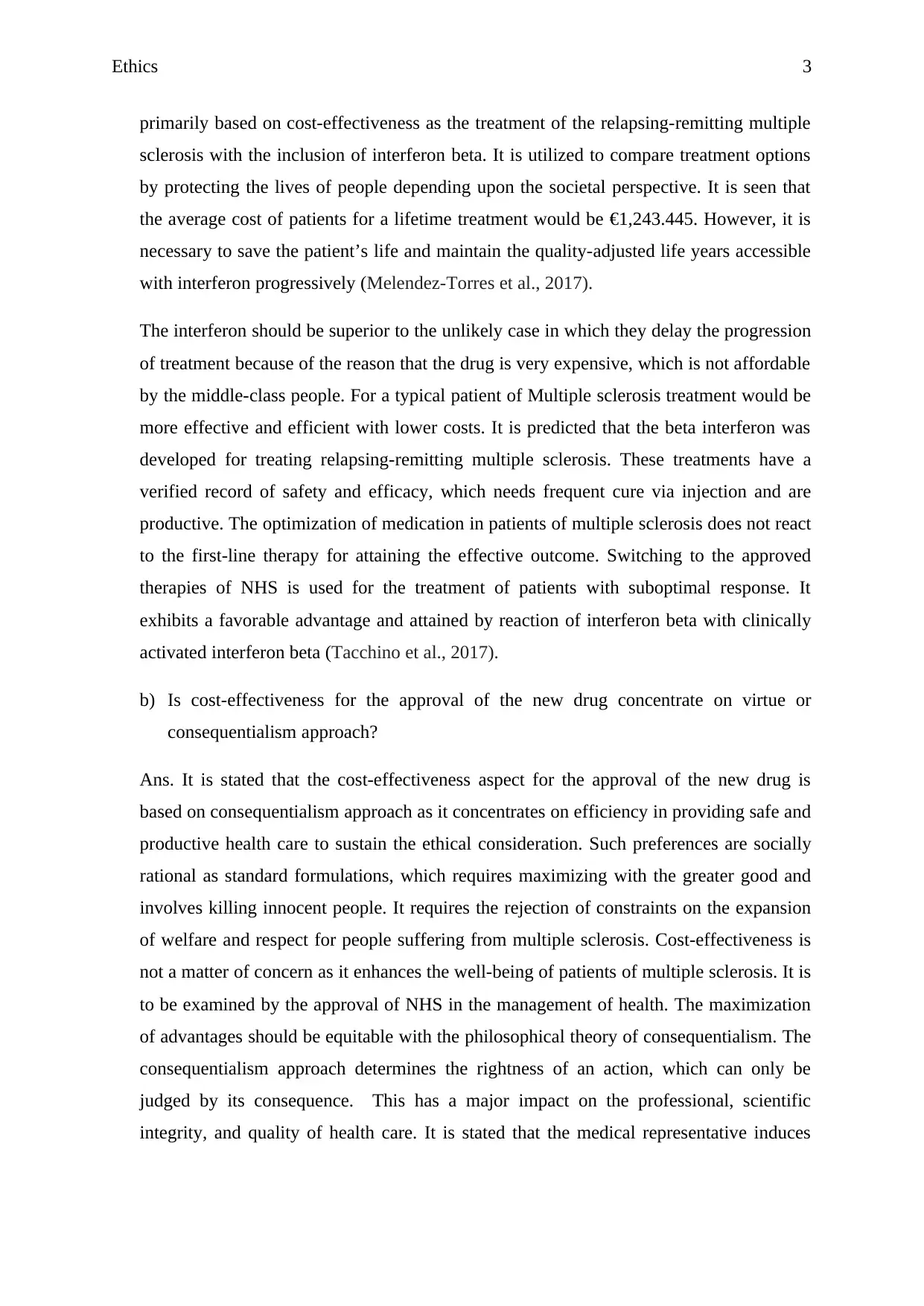
Ethics 3
primarily based on cost-effectiveness as the treatment of the relapsing-remitting multiple
sclerosis with the inclusion of interferon beta. It is utilized to compare treatment options
by protecting the lives of people depending upon the societal perspective. It is seen that
the average cost of patients for a lifetime treatment would be €1,243.445. However, it is
necessary to save the patient’s life and maintain the quality-adjusted life years accessible
with interferon progressively (Melendez-Torres et al., 2017).
The interferon should be superior to the unlikely case in which they delay the progression
of treatment because of the reason that the drug is very expensive, which is not affordable
by the middle-class people. For a typical patient of Multiple sclerosis treatment would be
more effective and efficient with lower costs. It is predicted that the beta interferon was
developed for treating relapsing-remitting multiple sclerosis. These treatments have a
verified record of safety and efficacy, which needs frequent cure via injection and are
productive. The optimization of medication in patients of multiple sclerosis does not react
to the first-line therapy for attaining the effective outcome. Switching to the approved
therapies of NHS is used for the treatment of patients with suboptimal response. It
exhibits a favorable advantage and attained by reaction of interferon beta with clinically
activated interferon beta (Tacchino et al., 2017).
b) Is cost-effectiveness for the approval of the new drug concentrate on virtue or
consequentialism approach?
Ans. It is stated that the cost-effectiveness aspect for the approval of the new drug is
based on consequentialism approach as it concentrates on efficiency in providing safe and
productive health care to sustain the ethical consideration. Such preferences are socially
rational as standard formulations, which requires maximizing with the greater good and
involves killing innocent people. It requires the rejection of constraints on the expansion
of welfare and respect for people suffering from multiple sclerosis. Cost-effectiveness is
not a matter of concern as it enhances the well-being of patients of multiple sclerosis. It is
to be examined by the approval of NHS in the management of health. The maximization
of advantages should be equitable with the philosophical theory of consequentialism. The
consequentialism approach determines the rightness of an action, which can only be
judged by its consequence. This has a major impact on the professional, scientific
integrity, and quality of health care. It is stated that the medical representative induces
primarily based on cost-effectiveness as the treatment of the relapsing-remitting multiple
sclerosis with the inclusion of interferon beta. It is utilized to compare treatment options
by protecting the lives of people depending upon the societal perspective. It is seen that
the average cost of patients for a lifetime treatment would be €1,243.445. However, it is
necessary to save the patient’s life and maintain the quality-adjusted life years accessible
with interferon progressively (Melendez-Torres et al., 2017).
The interferon should be superior to the unlikely case in which they delay the progression
of treatment because of the reason that the drug is very expensive, which is not affordable
by the middle-class people. For a typical patient of Multiple sclerosis treatment would be
more effective and efficient with lower costs. It is predicted that the beta interferon was
developed for treating relapsing-remitting multiple sclerosis. These treatments have a
verified record of safety and efficacy, which needs frequent cure via injection and are
productive. The optimization of medication in patients of multiple sclerosis does not react
to the first-line therapy for attaining the effective outcome. Switching to the approved
therapies of NHS is used for the treatment of patients with suboptimal response. It
exhibits a favorable advantage and attained by reaction of interferon beta with clinically
activated interferon beta (Tacchino et al., 2017).
b) Is cost-effectiveness for the approval of the new drug concentrate on virtue or
consequentialism approach?
Ans. It is stated that the cost-effectiveness aspect for the approval of the new drug is
based on consequentialism approach as it concentrates on efficiency in providing safe and
productive health care to sustain the ethical consideration. Such preferences are socially
rational as standard formulations, which requires maximizing with the greater good and
involves killing innocent people. It requires the rejection of constraints on the expansion
of welfare and respect for people suffering from multiple sclerosis. Cost-effectiveness is
not a matter of concern as it enhances the well-being of patients of multiple sclerosis. It is
to be examined by the approval of NHS in the management of health. The maximization
of advantages should be equitable with the philosophical theory of consequentialism. The
consequentialism approach determines the rightness of an action, which can only be
judged by its consequence. This has a major impact on the professional, scientific
integrity, and quality of health care. It is stated that the medical representative induces
Paraphrase This Document
Need a fresh take? Get an instant paraphrase of this document with our AI Paraphraser
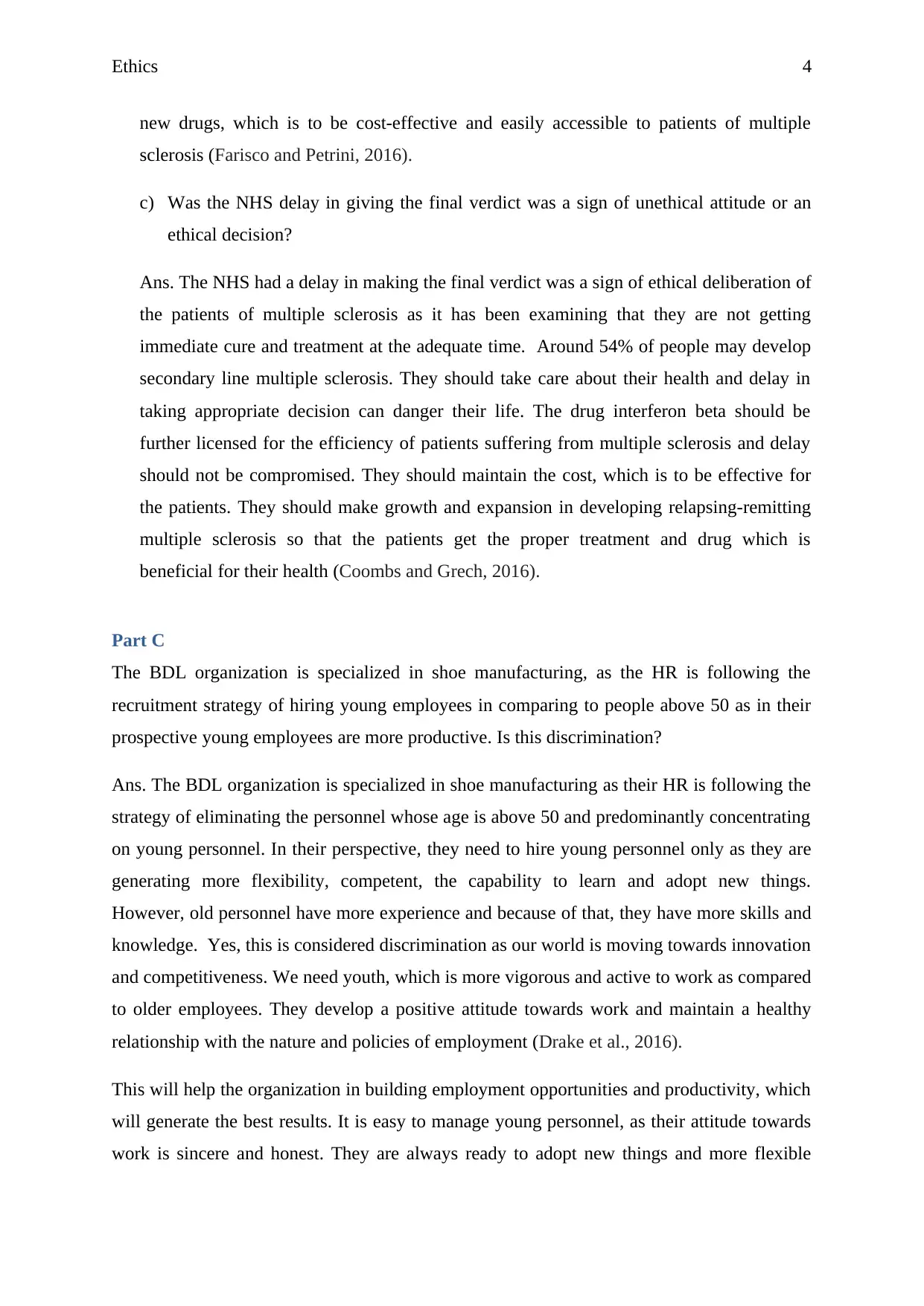
Ethics 4
new drugs, which is to be cost-effective and easily accessible to patients of multiple
sclerosis (Farisco and Petrini, 2016).
c) Was the NHS delay in giving the final verdict was a sign of unethical attitude or an
ethical decision?
Ans. The NHS had a delay in making the final verdict was a sign of ethical deliberation of
the patients of multiple sclerosis as it has been examining that they are not getting
immediate cure and treatment at the adequate time. Around 54% of people may develop
secondary line multiple sclerosis. They should take care about their health and delay in
taking appropriate decision can danger their life. The drug interferon beta should be
further licensed for the efficiency of patients suffering from multiple sclerosis and delay
should not be compromised. They should maintain the cost, which is to be effective for
the patients. They should make growth and expansion in developing relapsing-remitting
multiple sclerosis so that the patients get the proper treatment and drug which is
beneficial for their health (Coombs and Grech, 2016).
Part C
The BDL organization is specialized in shoe manufacturing, as the HR is following the
recruitment strategy of hiring young employees in comparing to people above 50 as in their
prospective young employees are more productive. Is this discrimination?
Ans. The BDL organization is specialized in shoe manufacturing as their HR is following the
strategy of eliminating the personnel whose age is above 50 and predominantly concentrating
on young personnel. In their perspective, they need to hire young personnel only as they are
generating more flexibility, competent, the capability to learn and adopt new things.
However, old personnel have more experience and because of that, they have more skills and
knowledge. Yes, this is considered discrimination as our world is moving towards innovation
and competitiveness. We need youth, which is more vigorous and active to work as compared
to older employees. They develop a positive attitude towards work and maintain a healthy
relationship with the nature and policies of employment (Drake et al., 2016).
This will help the organization in building employment opportunities and productivity, which
will generate the best results. It is easy to manage young personnel, as their attitude towards
work is sincere and honest. They are always ready to adopt new things and more flexible
new drugs, which is to be cost-effective and easily accessible to patients of multiple
sclerosis (Farisco and Petrini, 2016).
c) Was the NHS delay in giving the final verdict was a sign of unethical attitude or an
ethical decision?
Ans. The NHS had a delay in making the final verdict was a sign of ethical deliberation of
the patients of multiple sclerosis as it has been examining that they are not getting
immediate cure and treatment at the adequate time. Around 54% of people may develop
secondary line multiple sclerosis. They should take care about their health and delay in
taking appropriate decision can danger their life. The drug interferon beta should be
further licensed for the efficiency of patients suffering from multiple sclerosis and delay
should not be compromised. They should maintain the cost, which is to be effective for
the patients. They should make growth and expansion in developing relapsing-remitting
multiple sclerosis so that the patients get the proper treatment and drug which is
beneficial for their health (Coombs and Grech, 2016).
Part C
The BDL organization is specialized in shoe manufacturing, as the HR is following the
recruitment strategy of hiring young employees in comparing to people above 50 as in their
prospective young employees are more productive. Is this discrimination?
Ans. The BDL organization is specialized in shoe manufacturing as their HR is following the
strategy of eliminating the personnel whose age is above 50 and predominantly concentrating
on young personnel. In their perspective, they need to hire young personnel only as they are
generating more flexibility, competent, the capability to learn and adopt new things.
However, old personnel have more experience and because of that, they have more skills and
knowledge. Yes, this is considered discrimination as our world is moving towards innovation
and competitiveness. We need youth, which is more vigorous and active to work as compared
to older employees. They develop a positive attitude towards work and maintain a healthy
relationship with the nature and policies of employment (Drake et al., 2016).
This will help the organization in building employment opportunities and productivity, which
will generate the best results. It is easy to manage young personnel, as their attitude towards
work is sincere and honest. They are always ready to adopt new things and more flexible
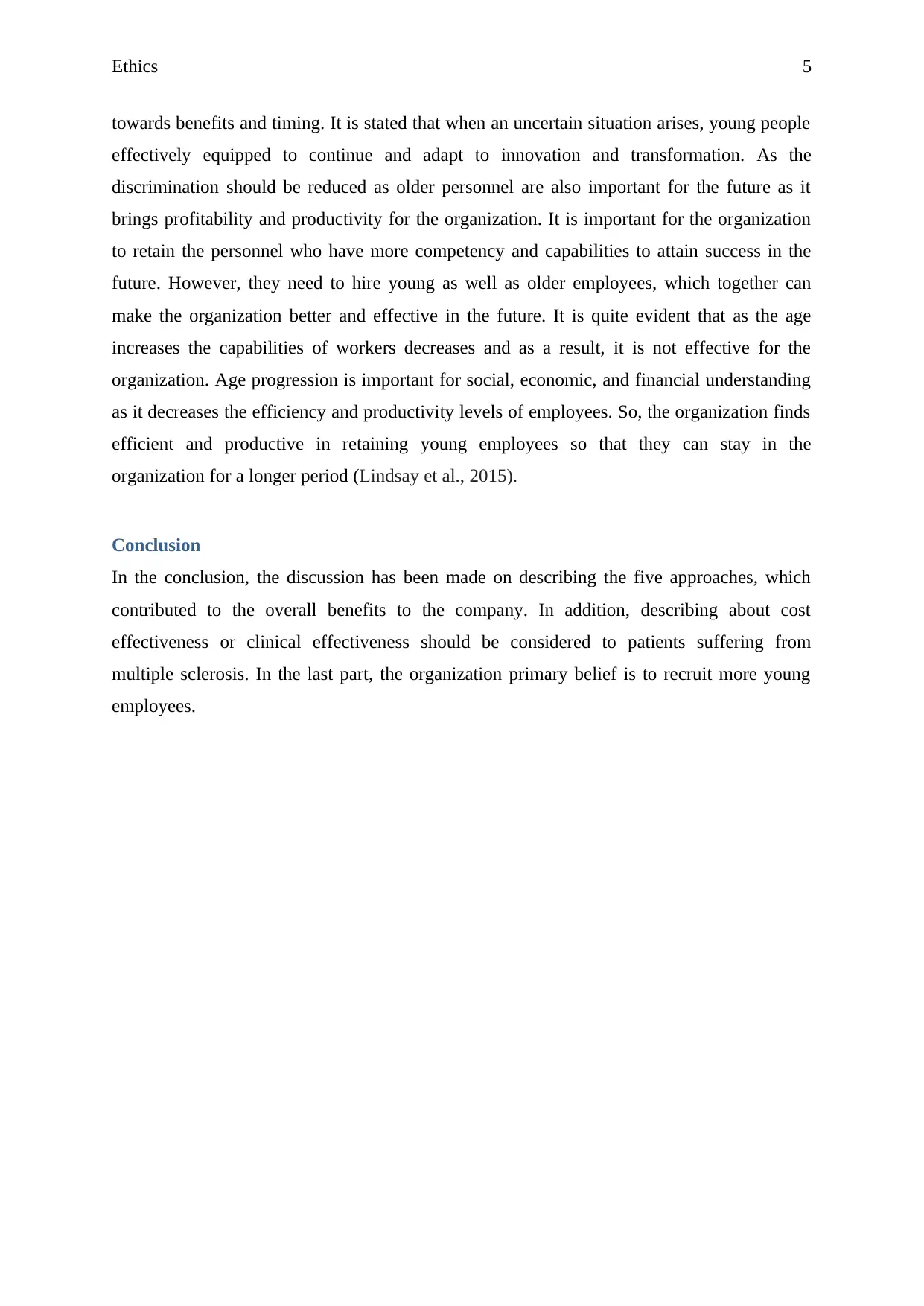
Ethics 5
towards benefits and timing. It is stated that when an uncertain situation arises, young people
effectively equipped to continue and adapt to innovation and transformation. As the
discrimination should be reduced as older personnel are also important for the future as it
brings profitability and productivity for the organization. It is important for the organization
to retain the personnel who have more competency and capabilities to attain success in the
future. However, they need to hire young as well as older employees, which together can
make the organization better and effective in the future. It is quite evident that as the age
increases the capabilities of workers decreases and as a result, it is not effective for the
organization. Age progression is important for social, economic, and financial understanding
as it decreases the efficiency and productivity levels of employees. So, the organization finds
efficient and productive in retaining young employees so that they can stay in the
organization for a longer period (Lindsay et al., 2015).
Conclusion
In the conclusion, the discussion has been made on describing the five approaches, which
contributed to the overall benefits to the company. In addition, describing about cost
effectiveness or clinical effectiveness should be considered to patients suffering from
multiple sclerosis. In the last part, the organization primary belief is to recruit more young
employees.
towards benefits and timing. It is stated that when an uncertain situation arises, young people
effectively equipped to continue and adapt to innovation and transformation. As the
discrimination should be reduced as older personnel are also important for the future as it
brings profitability and productivity for the organization. It is important for the organization
to retain the personnel who have more competency and capabilities to attain success in the
future. However, they need to hire young as well as older employees, which together can
make the organization better and effective in the future. It is quite evident that as the age
increases the capabilities of workers decreases and as a result, it is not effective for the
organization. Age progression is important for social, economic, and financial understanding
as it decreases the efficiency and productivity levels of employees. So, the organization finds
efficient and productive in retaining young employees so that they can stay in the
organization for a longer period (Lindsay et al., 2015).
Conclusion
In the conclusion, the discussion has been made on describing the five approaches, which
contributed to the overall benefits to the company. In addition, describing about cost
effectiveness or clinical effectiveness should be considered to patients suffering from
multiple sclerosis. In the last part, the organization primary belief is to recruit more young
employees.
⊘ This is a preview!⊘
Do you want full access?
Subscribe today to unlock all pages.

Trusted by 1+ million students worldwide
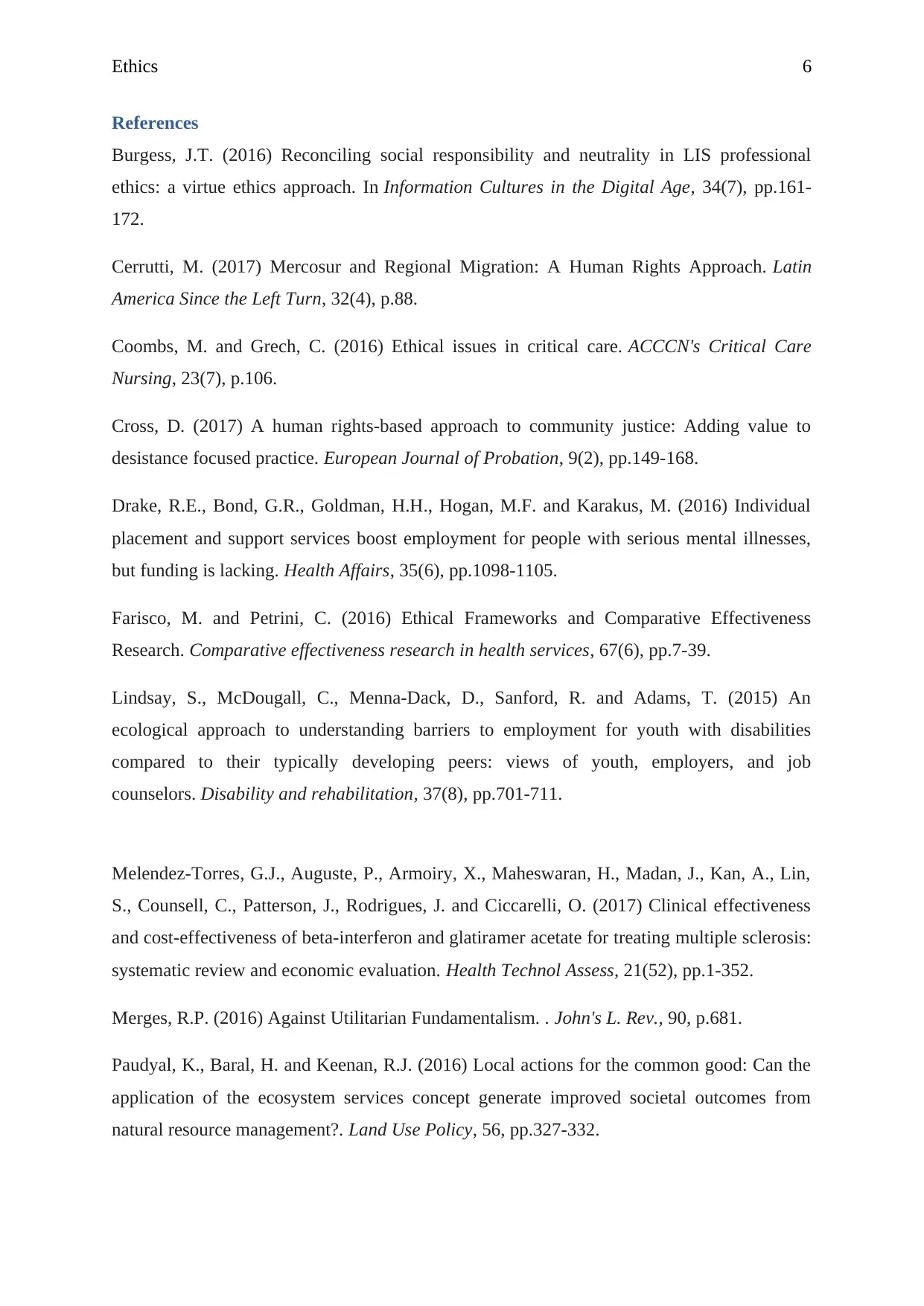
Ethics 6
References
Burgess, J.T. (2016) Reconciling social responsibility and neutrality in LIS professional
ethics: a virtue ethics approach. In Information Cultures in the Digital Age, 34(7), pp.161-
172.
Cerrutti, M. (2017) Mercosur and Regional Migration: A Human Rights Approach. Latin
America Since the Left Turn, 32(4), p.88.
Coombs, M. and Grech, C. (2016) Ethical issues in critical care. ACCCN's Critical Care
Nursing, 23(7), p.106.
Cross, D. (2017) A human rights-based approach to community justice: Adding value to
desistance focused practice. European Journal of Probation, 9(2), pp.149-168.
Drake, R.E., Bond, G.R., Goldman, H.H., Hogan, M.F. and Karakus, M. (2016) Individual
placement and support services boost employment for people with serious mental illnesses,
but funding is lacking. Health Affairs, 35(6), pp.1098-1105.
Farisco, M. and Petrini, C. (2016) Ethical Frameworks and Comparative Effectiveness
Research. Comparative effectiveness research in health services, 67(6), pp.7-39.
Lindsay, S., McDougall, C., Menna-Dack, D., Sanford, R. and Adams, T. (2015) An
ecological approach to understanding barriers to employment for youth with disabilities
compared to their typically developing peers: views of youth, employers, and job
counselors. Disability and rehabilitation, 37(8), pp.701-711.
Melendez-Torres, G.J., Auguste, P., Armoiry, X., Maheswaran, H., Madan, J., Kan, A., Lin,
S., Counsell, C., Patterson, J., Rodrigues, J. and Ciccarelli, O. (2017) Clinical effectiveness
and cost-effectiveness of beta-interferon and glatiramer acetate for treating multiple sclerosis:
systematic review and economic evaluation. Health Technol Assess, 21(52), pp.1-352.
Merges, R.P. (2016) Against Utilitarian Fundamentalism. . John's L. Rev., 90, p.681.
Paudyal, K., Baral, H. and Keenan, R.J. (2016) Local actions for the common good: Can the
application of the ecosystem services concept generate improved societal outcomes from
natural resource management?. Land Use Policy, 56, pp.327-332.
References
Burgess, J.T. (2016) Reconciling social responsibility and neutrality in LIS professional
ethics: a virtue ethics approach. In Information Cultures in the Digital Age, 34(7), pp.161-
172.
Cerrutti, M. (2017) Mercosur and Regional Migration: A Human Rights Approach. Latin
America Since the Left Turn, 32(4), p.88.
Coombs, M. and Grech, C. (2016) Ethical issues in critical care. ACCCN's Critical Care
Nursing, 23(7), p.106.
Cross, D. (2017) A human rights-based approach to community justice: Adding value to
desistance focused practice. European Journal of Probation, 9(2), pp.149-168.
Drake, R.E., Bond, G.R., Goldman, H.H., Hogan, M.F. and Karakus, M. (2016) Individual
placement and support services boost employment for people with serious mental illnesses,
but funding is lacking. Health Affairs, 35(6), pp.1098-1105.
Farisco, M. and Petrini, C. (2016) Ethical Frameworks and Comparative Effectiveness
Research. Comparative effectiveness research in health services, 67(6), pp.7-39.
Lindsay, S., McDougall, C., Menna-Dack, D., Sanford, R. and Adams, T. (2015) An
ecological approach to understanding barriers to employment for youth with disabilities
compared to their typically developing peers: views of youth, employers, and job
counselors. Disability and rehabilitation, 37(8), pp.701-711.
Melendez-Torres, G.J., Auguste, P., Armoiry, X., Maheswaran, H., Madan, J., Kan, A., Lin,
S., Counsell, C., Patterson, J., Rodrigues, J. and Ciccarelli, O. (2017) Clinical effectiveness
and cost-effectiveness of beta-interferon and glatiramer acetate for treating multiple sclerosis:
systematic review and economic evaluation. Health Technol Assess, 21(52), pp.1-352.
Merges, R.P. (2016) Against Utilitarian Fundamentalism. . John's L. Rev., 90, p.681.
Paudyal, K., Baral, H. and Keenan, R.J. (2016) Local actions for the common good: Can the
application of the ecosystem services concept generate improved societal outcomes from
natural resource management?. Land Use Policy, 56, pp.327-332.
Paraphrase This Document
Need a fresh take? Get an instant paraphrase of this document with our AI Paraphraser
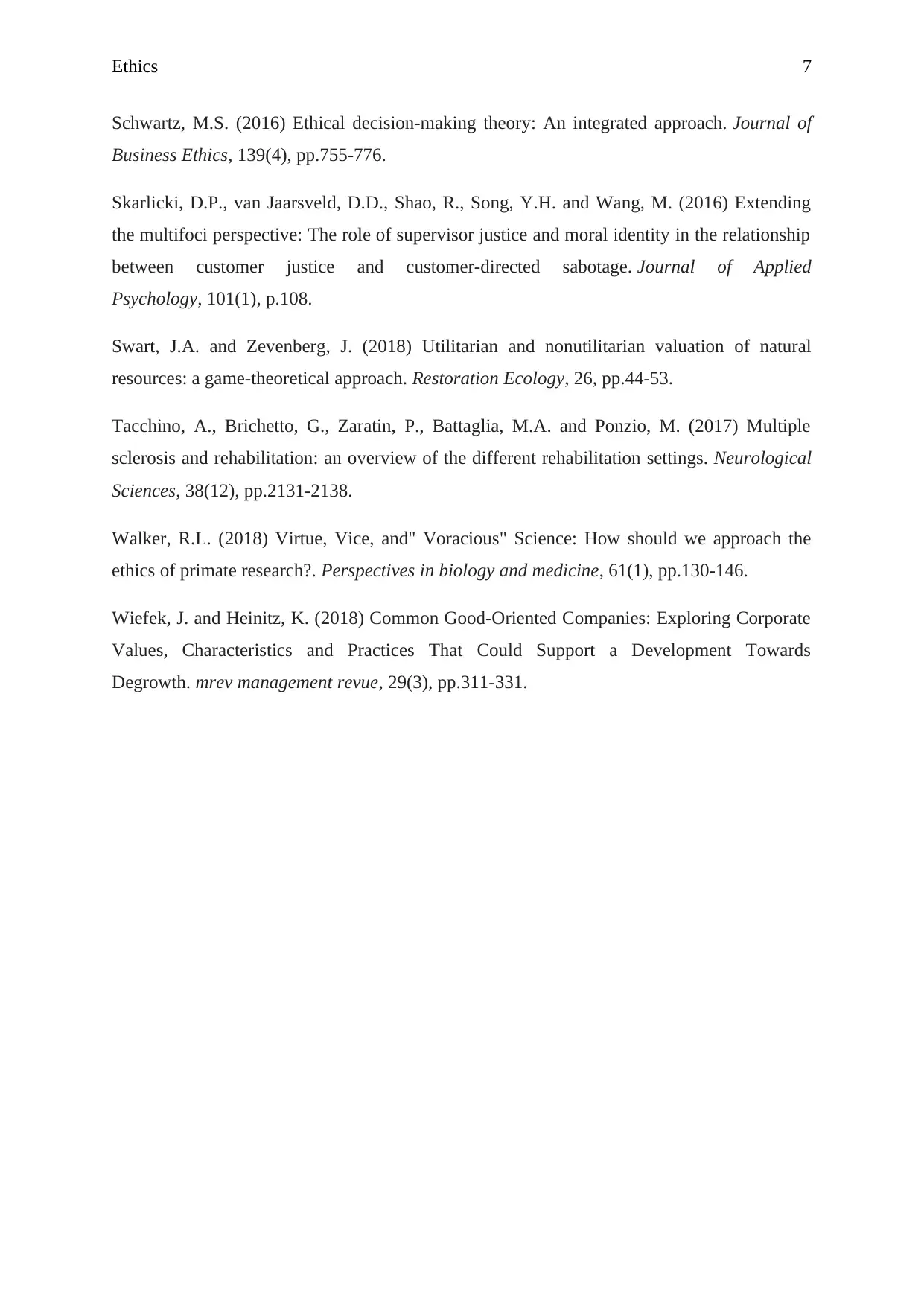
Ethics 7
Schwartz, M.S. (2016) Ethical decision-making theory: An integrated approach. Journal of
Business Ethics, 139(4), pp.755-776.
Skarlicki, D.P., van Jaarsveld, D.D., Shao, R., Song, Y.H. and Wang, M. (2016) Extending
the multifoci perspective: The role of supervisor justice and moral identity in the relationship
between customer justice and customer-directed sabotage. Journal of Applied
Psychology, 101(1), p.108.
Swart, J.A. and Zevenberg, J. (2018) Utilitarian and nonutilitarian valuation of natural
resources: a game‐theoretical approach. Restoration Ecology, 26, pp.44-53.
Tacchino, A., Brichetto, G., Zaratin, P., Battaglia, M.A. and Ponzio, M. (2017) Multiple
sclerosis and rehabilitation: an overview of the different rehabilitation settings. Neurological
Sciences, 38(12), pp.2131-2138.
Walker, R.L. (2018) Virtue, Vice, and" Voracious" Science: How should we approach the
ethics of primate research?. Perspectives in biology and medicine, 61(1), pp.130-146.
Wiefek, J. and Heinitz, K. (2018) Common Good-Oriented Companies: Exploring Corporate
Values, Characteristics and Practices That Could Support a Development Towards
Degrowth. mrev management revue, 29(3), pp.311-331.
Schwartz, M.S. (2016) Ethical decision-making theory: An integrated approach. Journal of
Business Ethics, 139(4), pp.755-776.
Skarlicki, D.P., van Jaarsveld, D.D., Shao, R., Song, Y.H. and Wang, M. (2016) Extending
the multifoci perspective: The role of supervisor justice and moral identity in the relationship
between customer justice and customer-directed sabotage. Journal of Applied
Psychology, 101(1), p.108.
Swart, J.A. and Zevenberg, J. (2018) Utilitarian and nonutilitarian valuation of natural
resources: a game‐theoretical approach. Restoration Ecology, 26, pp.44-53.
Tacchino, A., Brichetto, G., Zaratin, P., Battaglia, M.A. and Ponzio, M. (2017) Multiple
sclerosis and rehabilitation: an overview of the different rehabilitation settings. Neurological
Sciences, 38(12), pp.2131-2138.
Walker, R.L. (2018) Virtue, Vice, and" Voracious" Science: How should we approach the
ethics of primate research?. Perspectives in biology and medicine, 61(1), pp.130-146.
Wiefek, J. and Heinitz, K. (2018) Common Good-Oriented Companies: Exploring Corporate
Values, Characteristics and Practices That Could Support a Development Towards
Degrowth. mrev management revue, 29(3), pp.311-331.
1 out of 8
Related Documents
Your All-in-One AI-Powered Toolkit for Academic Success.
+13062052269
info@desklib.com
Available 24*7 on WhatsApp / Email
![[object Object]](/_next/static/media/star-bottom.7253800d.svg)
Unlock your academic potential
Copyright © 2020–2025 A2Z Services. All Rights Reserved. Developed and managed by ZUCOL.





